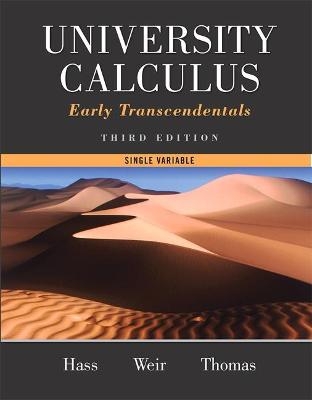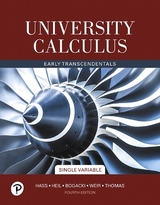
University Calculus
Pearson (Verlag)
978-0-321-99963-4 (ISBN)
- Titel erscheint in neuer Auflage
- Artikel merken
If you would like to purchase both the physical text and MyMathLab, search for:
0321999592 / 9780321999597 University Calculus, Early Transcendentals, Single Variable Plus MyMathLab -- Access Card Package
Package consists of:
0321431308 / 9780321431301 MyMathLab -- Glue-in Access Card
0321654064 / 9780321654069 MyMathLab Inside Star Sticker
0321999630 / 9780321999634 University Calculus, Early Transcendentals, Single Variable
University Calculus, Early Transcendentals, Third Edition helps students generalize and apply the key ideas of calculus through clear and precise explanations, thoughtfully chosen examples, meticulously crafted figures, and superior exercise sets. This text offers the right mix of basic, conceptual, and challenging exercises, along with meaningful applications. This revision features more examples, more mid-level exercises, more figures, improved conceptual flow, and the best in technology for learning and teaching.
Joel Hass received his PhD from the University of California—Berkeley. He is currently a professor of mathematics at the University of California—Davis. He has coauthored six widely used calculus texts as well as two calculus study guides. He is currently on the editorial board of Geometriae Dedicata and Media-Enhanced Mathematics. He has been a member of the Institute for Advanced Study at Princeton University and of the Mathematical Sciences Research Institute, and he was a Sloan Research Fellow. Hass’s current areas of research include the geometry of proteins, three dimensional manifolds, applied math, and computational complexity. In his free time, Hass enjoys kayaking. Maurice D. Weir holds a DA and MS from Carnegie-Mellon University and received his BS at Whitman College. He is a Professor Emeritus of the Department of Applied Mathematics at the Naval Postgraduate School in Monterey, California. Weir enjoys teaching Mathematical Modeling and Differential Equations. His current areas of research include modeling and simulation as well as mathematics education. Weir has been awarded the Outstanding Civilian Service Medal, the Superior Civilian Service Award, and the Schieffelin Award for Excellence in Teaching. He has coauthored eight books, including the University Calculus series and Thomas’ Calculus.
1. Functions
1.1 Functions and Their Graphs
1.2 Combining Functions; Shifting and Scaling Graphs
1.3 Trigonometric Functions
1.4 Graphing with Calculators and Computers
1.5 Exponential Functions
1.6 Inverse Functions and Logarithms
2. Limits and Continuity
2.1 Rates of Change and Tangents to Curves
2.2 Limit of a Function and Limit Laws
2.3 The Precise Definition of a Limit
2.4 One-Sided Limits
2.5 Continuity
2.6 Limits Involving Infinity; Asymptotes of Graphs
3. Differentiation
3.1 Tangents and the Derivative at a Point
3.2 The Derivative as a Function
3.3 Differentiation Rules
3.4 The Derivative as a Rate of Change
3.5 Derivatives of Trigonometric Functions
3.6 The Chain Rule
3.7 Implicit Differentiation
3.8 Derivatives of Inverse Functions and Logarithms
3.9 Inverse Trigonometric Functions
3.10 Related Rates
3.11 Linearization and Differentials
4. Applications of Derivatives
4.1 Extreme Values of Functions
4.2 The Mean Value Theorem
4.3 Monotonic Functions and the First Derivative Test
4.4 Concavity and Curve Sketching
4.5 Indeterminate Forms and L'Hôpital's Rule
4.6 Applied Optimization
4.7 Newton's Method
4.8 Antiderivatives
5. Integration
5.1 Area and Estimating with Finite Sums
5.2 Sigma Notation and Limits of Finite Sums
5.3 The Definite Integral
5.4 The Fundamental Theorem of Calculus
5.5 Indefinite Integrals and the Substitution Rule
5.6 Substitution and Area Between Curves
6. Applications of Definite Integrals
6.1 Volumes Using Cross-Sections
6.2 Volumes Using Cylindrical Shells
6.3 Arc Length
6.4 Areas of Surfaces of Revolution
6.5 Work
6.6 Moments and Centers of Mass
7. Integrals and Transcendental Functions
7.1 The Logarithm Defined as an Integral
7.2 Exponential Change and Separable Differential Equations
7.3 Hyperbolic Functions
8. Techniques of Integration
8.1 Integration by Parts
8.2 Trigonometric Integrals
8.3 Trigonometric Substitutions
8.4 Integration of Rational Functions by Partial Fractions
8.5 Integral Tables and Computer Algebra Systems
8.6 Numerical Integration
8.7 Improper Integrals
9. Infinite Sequences and Series
9.1 Sequences
9.2 Infinite Series
9.3 The Integral Test
9.4 Comparison Tests
9.5 The Ratio and Root Tests
9.6 Alternating Series, Absolute and Conditional Convergence
9.7 Power Series
9.8 Taylor and Maclaurin Series
9.9 Convergence of Taylor Series
9.10 The Binomial Series and Applications of Taylor Series
10. Parametric Equations and Polar Coordinates
10.1 Parametrizations of Plane Curves
10.2 Calculus with Parametric Curves
10.3 Polar Coordinates
10.4 Graphing in Polar Coordinates
10.5 Areas and Lengths in Polar Coordinates
10.6 Conics in Polar Coordinates
16. First-Order Differential Equations (Online)
16.1 Solutions, Slope Fields, and Euler's Method
16.2 First-Order Linear Equations
16.3 Applications
16.4 Graphical Solutions of Autonomous Equations
16.5 Systems of Equations and Phase Planes
| Erscheint lt. Verlag | 13.1.2015 |
|---|---|
| Sprache | englisch |
| Maße | 215 x 280 mm |
| Gewicht | 1428 g |
| Themenwelt | Mathematik / Informatik ► Mathematik ► Analysis |
| ISBN-10 | 0-321-99963-0 / 0321999630 |
| ISBN-13 | 978-0-321-99963-4 / 9780321999634 |
| Zustand | Neuware |
| Haben Sie eine Frage zum Produkt? |
aus dem Bereich



